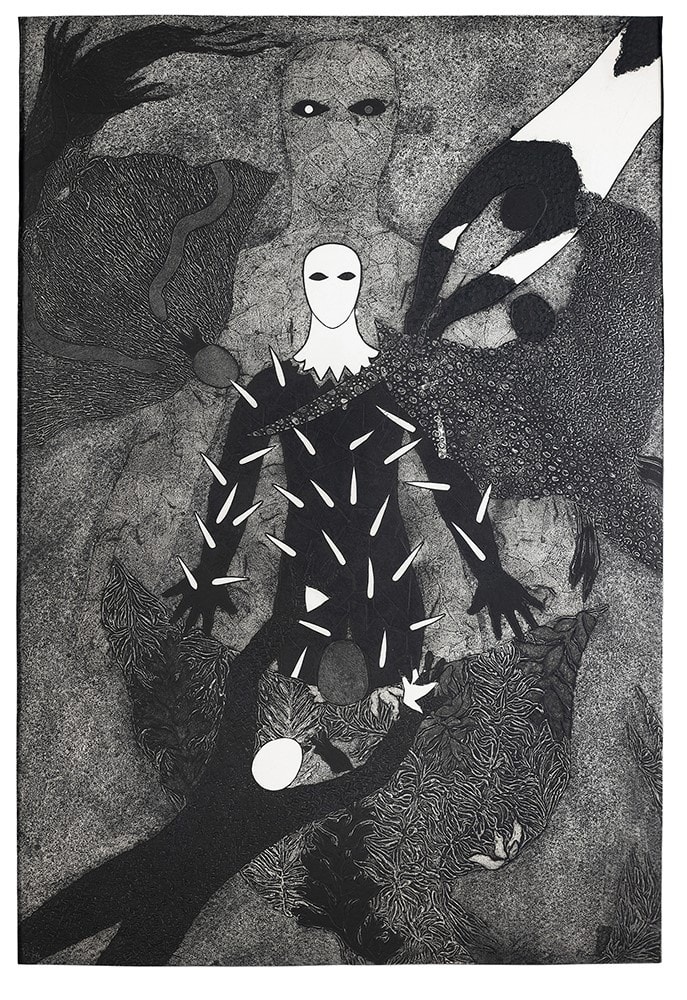Belkis Ayón
La Habana, Cuba, 1967 - 1999
“Art is the path, the way, the solution I found to say what I meant”
Inspired by the Afro-Cuban secret society Abakuá, a fraternity exclusively for men that arrives in Cuba thanks to Nigerian immigration, Belkis Ayón found a way to explore the representation of the role of women, religion and power systems.
The Abakuá legend tells that the secret of the society rested in a sacred fish. A fish that was also the bearer of the group's voice, a tribal song that caged the essence of this mysterious brotherhood. Unknowingly, the innocent princess Sikan captured it on the riverbank and ate it. Fearing that she would reveal the secret and put the Abakuá at risk, the princess was sacrificed by her own father, who presided over the lodge.
Belkis, who had no relationship with the Abakuá, creates a world and a symbology to tell this story. Using the little-known engraving technique called collagraphy, her works portray ritual moments and scenes of betrayal, esotericism, and darkness. The characters frequently do not have mouths or irises and seem to be suspended in a dark mist surrounded by scaly snakes, which at times seem to protect them and, at others, choke them.
Ayón mentioned in an interview that "Actually, the eyes in my work are what impresses people, what intrigues them, because these eyes stare at you". And she added: "So I believe you can't hide, wherever you move they are always there, staring at you, making you an accomplice of what you are seeing."
The androgynous figures in her works twine in silent power struggles. Each print looks like the scene of a story we are not sure to be allowed to witness. Suspended in time, they conjugate symbols and languages from all cultures and none; Belkis takes symbolic burdens out of context and makes them her own to generate intimate images of a story that is not defined as reality or fiction.
With abundant exhibitions of her work around the world, and after having participated in the Venice Biennale twice, Belkis, at the age of 32, took her own life, leaving behind a legacy of curiosity for cultural exploration related to allegory, gender and identity, embodied in dramatic works with a sacred halo.
![Belkis Ayón, Añoranza [Longing], 1998](https://artlogic-res.cloudinary.com/w_600,c_limit,f_auto,fl_lossy,q_auto/artlogicstorage/balanz/images/view/539f2ca33201dd5e16e45f195bf68b1bj/coleccionbalanz-belkis-ay-n-a-oranza-longing-1998.jpg)
![Belkis Ayón, Siempre vuelvo [I Always Return], 1994](https://artlogic-res.cloudinary.com/w_600,c_limit,f_auto,fl_lossy,q_auto/artlogicstorage/balanz/images/view/e78812ab7783de55b9677631ad9a7a5dj/coleccionbalanz-belkis-ay-n-siempre-vuelvo-i-always-return-1994.jpg)
![Belkis Ayón, Sin título (mujer en posición fetal) [Untitled (Woman in fetal position)], 1996](https://artlogic-res.cloudinary.com/w_600,c_limit,f_auto,fl_lossy,q_auto/artlogicstorage/balanz/images/view/984cfc44d221935f19031d1575a9ae22j/coleccionbalanz-belkis-ay-n-sin-t-tulo-mujer-en-posici-n-fetal-untitled-woman-in-fetal-position-1996.jpg)


